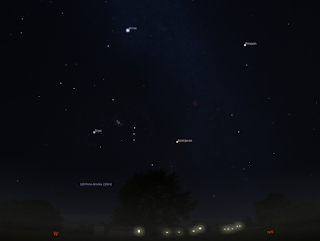Monday, May 06, 2024
Thursday May 9 to Thursday May 16
The First Quarter Moon is Wednesday, May 15. Comet 12P Pons-Brooks is now visible when the sky is fully dark but is still a binocular only object. The comet will progressively climb higher and is near the iconic Orion constellation. In the morning the lineup of Saturn, Mars and Mercury makes for nice viewing.
The First Quarter Moon is Wednesday, May 15.
While the comet is a modestly bright magnitude 5, despite now being visible when the sky is fully dark, you will still need binoculars. Over the week the comet will climb towards Orion and into darker skies, but becomes dimmer as it rises. Updated spotters charts are here.
Similar views will be seen from the rest of Australia at the equivalent local time (90 minutes after sunset).
Evening sky on Thursday, May 16 as seen from Adelaide at 18:52 ACST (90 minutes after sunset, click to embiggen). Comet 12P is now just below Orion when the sky is fully dark. The inset shows the binocular view at this time.While the comet is a reasonable bright magnitude 5.4, you will still need binoculars. Over the week the comet will climb higher into darker skies and closer to the bright stars of Orion. Updated spotters charts are here.
Similar views will be seen from the rest of Australia at the equivalent local time (90 minutes after sunset).
Elsewhere in Australia will see a similar view at the equivalent time (90 minutes after sunset).
Mercury begins to sink into the twilight.
Venus is lost in the morning twilight.
Mars is rising in the morning twilight.
Jupiter is lost in the twilight sky.
Saturn climbs higher in the morning twilight.
Star Map via Virtual sky. Use your mouse to scroll around and press 8 when your pointer is in the map to set to the current time.
Cloud cover predictions can be found at SkippySky.
Here is the near-real time satellite view of the clouds (day and night) http://satview.bom.gov.au/
Labels: weekly sky





 Click to read about or order
Click to read about or order Click to read about or order
Click to read about or order Click to read about or order
Click to read about or order Click to read about or order
Click to read about or order